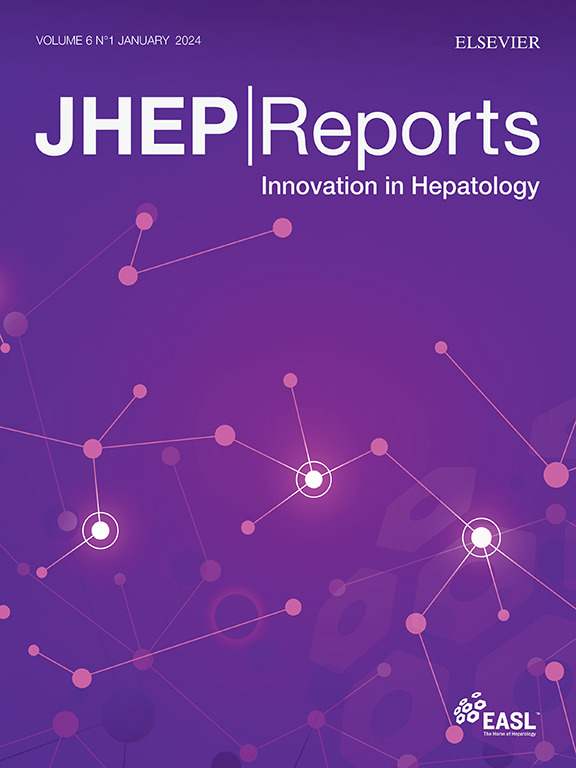Proinflammatory macrophages release CXCL5 to regulate T cell function and limit effects of αPD-1 in steatosis-driven liver cancer
IF 9.5
1区 医学
Q1 GASTROENTEROLOGY & HEPATOLOGY
引用次数: 0
Abstract
Background & Aims
Steatosis is a comorbid factor for cancer development. Patients with steatosis do not respond well to current immune checkpoint therapy (CPI) treatment. We explored the roles of neutrophil-activating chemokines (NACs) in the response of steatosis/liver cancer to CPI.
Methods
We used a steatosis-driven liver cancer model induced by the deletion of Pten in the liver (LiPten) and a high-fat diet + carbon tetrachloride (CCl4) fibrosis model to study the effects of targeting CXCL5. We also studied the role of CXCL5 in the liver immune microenvironment in vitro and in vivo. ANOVA/t tests were used for data analysis.
Results
Using LiPten steatosis-tumor mice, we identified CXCL5 as the NAC most robustly upregulated as steatosis progresses to cancer (>100 fold, n = 6–11). We also validated this observation in patient samples. When used together with αPD-1, inhibiting the NAC receptor CXCR2 promoted (100% vs. 80% in untreated LiPten mice), whereas anti-CXCL5 suppressed (25%), tumor progression (n = 4–6) suggesting unique functions of CXCL5 independent of CXCR2. Similar effects were observed for anti-CXCL5 (0/4 with fibrosis) vs. CXCR2 inhibition (4/4 with fibrosis) of fibrosis in the HFD + CCl4 model. Using a Transwell assay, we identified a novel inhibitory function of CXCL5 in the recruitment of CD4+ T cells (p <0.02, n = 4) and potentiation of CD8+ T cell cytotoxicity (p <0.001, n = 4). In vivo, we showed that neutralizing CXCL5 increased the CD8/CD4 ratio (p = 0.03 and 0.07) and synergized with αPD-1 for its anti-tumor and anti-fibrosis activity (n = 4–6).
Conclusions
Our discovery of the novel inhibitory role of CXCL5 in T cells suggests that NACs have additional functions in modulating the immune system beyond neutrophil chemotaxis. The discovery of this novel CXCL5 role presents additional therapeutical targets alongside current immune checkpoint therapy.
Impact and implications
In this study, we investigated the role of CXCL5 in the progression from steatosis to liver cancer. We uncovered a novel inhibitory role of CXCL5 in T cell recruitment, with implications for NAC-targeted therapy and immune checkpoint synergy in liver cancer. We believe our findings will be of interest to physicians, researchers, and patients interested in therapeutic development and translational research in liver disease.
促炎巨噬细胞释放CXCL5调节T细胞功能,限制αPD-1在脂肪变性肝癌中的作用
背景,目的脂肪变性是癌症发展的合并症。脂肪变性患者对目前的免疫检查点疗法(CPI)治疗反应不佳。我们探讨了中性粒细胞激活趋化因子(NACs)在脂肪变性/肝癌对CPI的反应中的作用。方法采用肝脏Pten缺失诱导的脂肪变性肝癌模型(LiPten)和高脂饮食+四氯化碳(CCl4)纤维化模型,研究靶向CXCL5的作用。我们还研究了CXCL5在体外和体内肝脏免疫微环境中的作用。数据分析采用方差分析/t检验。结果使用LiPten脂肪变性肿瘤小鼠,我们发现CXCL5是脂肪变性进展为癌症时最强烈上调的NAC (>;100倍,n = 6-11)。我们还在患者样本中验证了这一观察结果。当与αPD-1联合使用时,抑制NAC受体CXCR2促进(100% vs.未治疗LiPten小鼠的80%),而抗CXCL5抑制(25%),肿瘤进展(n = 4-6),表明CXCL5独立于CXCR2的独特功能。在HFD + CCl4模型中,抗cxcl5(0/4伴纤维化)与CXCR2抑制(4/4伴纤维化)对纤维化的影响相似。通过Transwell实验,我们发现CXCL5在募集CD4+ T细胞(p <0.02, n = 4)和增强CD8+ T细胞毒性(p <0.001, n = 4)方面具有新的抑制功能。在体内,我们发现中和CXCL5增加了CD8/CD4比值(p = 0.03和0.07),并与αPD-1协同抗肿瘤和抗纤维化活性(n = 4-6)。结论CXCL5在T细胞中的新抑制作用的发现表明NACs在调节免疫系统中具有中性粒细胞趋化性之外的其他功能。这种新的CXCL5作用的发现为当前的免疫检查点治疗提供了额外的治疗靶点。在这项研究中,我们研究了CXCL5在脂肪变性到肝癌发展过程中的作用。我们发现了CXCL5在T细胞募集中的新抑制作用,这对肝癌的nac靶向治疗和免疫检查点协同作用具有重要意义。我们相信,我们的研究结果将引起对肝病治疗开发和转化研究感兴趣的医生、研究人员和患者的兴趣。
本文章由计算机程序翻译,如有差异,请以英文原文为准。
求助全文
约1分钟内获得全文
求助全文
来源期刊

JHEP Reports
GASTROENTEROLOGY & HEPATOLOGY-
CiteScore
12.40
自引率
2.40%
发文量
161
审稿时长
36 days
期刊介绍:
JHEP Reports is an open access journal that is affiliated with the European Association for the Study of the Liver (EASL). It serves as a companion journal to the highly respected Journal of Hepatology.
The primary objective of JHEP Reports is to publish original papers and reviews that contribute to the advancement of knowledge in the field of liver diseases. The journal covers a wide range of topics, including basic, translational, and clinical research. It also focuses on global issues in hepatology, with particular emphasis on areas such as clinical trials, novel diagnostics, precision medicine and therapeutics, cancer research, cellular and molecular studies, artificial intelligence, microbiome research, epidemiology, and cutting-edge technologies.
In summary, JHEP Reports is dedicated to promoting scientific discoveries and innovations in liver diseases through the publication of high-quality research papers and reviews covering various aspects of hepatology.
 求助内容:
求助内容: 应助结果提醒方式:
应助结果提醒方式:


